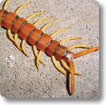Invertebrates
 Invertebrates comprise more than 95 percent of all known animal species on the planet, which means that legions of individual arthropods and scores of related species are walking, flying, and swimming across the Northern Jaguar Reserve each day. From damselflies and beetles to butterflies and moths, NJP began describing the myriad insects found on the reserve in 2006. We plan to continue to survey those invertebrates inhabiting these lands and waters.
Invertebrates comprise more than 95 percent of all known animal species on the planet, which means that legions of individual arthropods and scores of related species are walking, flying, and swimming across the Northern Jaguar Reserve each day. From damselflies and beetles to butterflies and moths, NJP began describing the myriad insects found on the reserve in 2006. We plan to continue to survey those invertebrates inhabiting these lands and waters.
 Inventories of butterflies and moths, which began primarily at Rancho Los Pavos, have provided a better understanding of conservation needs. Our sponsored expeditions have already identified nearly 100 butterfly species at the reserve, with numerous range extensions. Among these is the easternmost locale in Sonora for an endemic owl butterfly, Opsiphanes blythekitzmillerae. There’s also Argia anceps, a narrow-winged damselfly found dancing at the northernmost edge of its known range.
Inventories of butterflies and moths, which began primarily at Rancho Los Pavos, have provided a better understanding of conservation needs. Our sponsored expeditions have already identified nearly 100 butterfly species at the reserve, with numerous range extensions. Among these is the easternmost locale in Sonora for an endemic owl butterfly, Opsiphanes blythekitzmillerae. There’s also Argia anceps, a narrow-winged damselfly found dancing at the northernmost edge of its known range.
A large number of insects spend at least part of their lives underwater. More than 100 species of aquatic invertebrates have been found along the Río Aros and its tributaries, with beetles making up more than half the species identified. Again, we have found a number of species that have extended far beyond their previously known boundaries. Two backswimmers and a diving beetle are the northernmost examples of their species. Yet another species of backswimmer, Martarega mexicana, had previously only been sighted in central Mexico and along river drainages in Arizona. Seeing this water bug on the reserve marked its first catalogued occurrence in the large gap between these two distinct regions.

